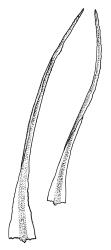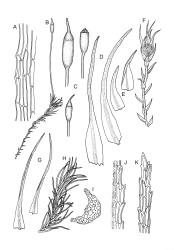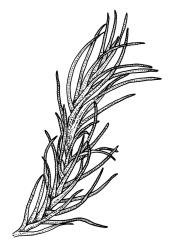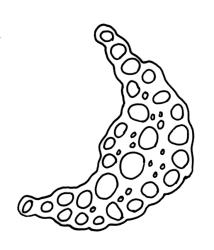- ≡ Dicranum heteromallum Hedw., Sp. Musc. Frond. 128 (1801)
The following description is based on N.Z. material. As this is a widely distributed species in the northern hemisphere, more detailed descriptions may be found in many regional Floras.
Plants medium-sized, bright yellow-green. Stems c. 4–7 mm, in cross-section with a large central strand and 1–2 layers of firm-walled cortical cells. Leaves loosely secund, lacking a sheathing base, little altered when dry, evenly tapered from a lanceolate base to a long, acuminate, costa-filled subula, serrulate in upper half or more, c. 2.0 × 0.15–0.25 mm, plane at margins; mid laminal cells c. 2–3 on each side of the costa, narrowly rectangular, 15–21(–45) × c. 6 µm, mostly 2–4:1, firm-walled, smooth; cells of leaf base mostly 36–52 × 4–6 µm. Costa occupying ⅓–½ of the leaf base, well defined, long, excurrent and filling the subula, in cross-section with median guide cells and both abaxial and adaxial stereid groups, and with the cells on the adaxial surface more elongate than adjacent laminal cells. Tubers not seen.
Dioicous. Perichaetial leaves not differentiated. Perigonia terminal; bracts sheathing at base, abruptly tapered to a wide (c. 0.25 mm), oblong and pigmented base; the innermost bract short and lacking a subula. Setae pale, yellow-brown, c. 6 mm; capsules curved and asymmetric, c. 1.0–1.5 mm, lacking a struma, pale brown, mostly furrowed when dry.
Crum & Anderson 1981, fig. 72 e–i; Noguchi 1987–1994, fig. 59.
Dicranella heteromalla is superficially similar to Ditrichum brevirostre, but the latter species, despite having falcate-secund leaves, differs by having generally longer leaves, entire margins and percurrent costae. According to R.D. Seppelt (pers. comm., 17 Oct. 2017), in Tasmania the present species when fresh is darker in coloration than the more yellow-green D. brevirostre.
NI: N Auckland (Puketi), including offshore islands (Moturoa I.), Wellington (Wainuiomata).
Probably adventive. Tasmania*, widespread in the northern hemisphere. Cited from Europe including Britain, the Faeroes, Iceland, Caucasus, Turkey, Lebanon, Himalayas ("and northwards"), Malaysia, Macaronesia, Kenya, North America, and Bolivia by Smith (2004).
The Moturoa I. (Bay of Islands) collection (J.E. Beever 52-13a, CHR 462056) was made from soil on the vertical side of an intermittent watercourse beneath mānuka. Jessica Beever (pers. comm., 23 Aug. 1990) considered the population was "highly likely introduced". It was collected from "a recently fenced forest remnant surrounded by pasture, in a water course which drains in from the pasture". The Puketi collection (J.E. Beever 62-57, CHR 611200) came from vertical damp clay at a track margin, among the exotic subshrub Ageratina sp. and dicot herbs at the disturbed margin of Agathis australis forest. The Wainuiomata collection (P. Beveridge HA-9, WELT M040506) was collected from a "trackside soil mound under Eucalyptus sp.". All collections are from low-elevation sites.
The non-sheathing leaf bases, together with the loosely secund, serrulate and evenly tapered leaves with excurrent costae, distinguish this species from its congeners. The perigonia are representative of Dicranella, being terminal with bracts, which are more differentiated and wider (c. 0.25 mm) at their bases than vegetative leaves. The innermost bract is short and lacks a subula. The Moturoa and Puketi collections lack sporophytes, but the more recent Wainuiomata collection bears a few older capsules on yellowish setae. The pale setae with sulcate, asymmetric, and non-strumose capsules are consistent with plants from the northern hemisphere. This inconspicuous species will likely prove to be more widespread in N.Z.









